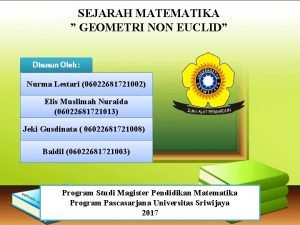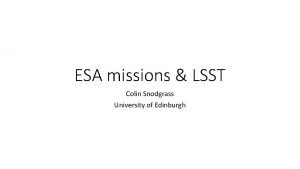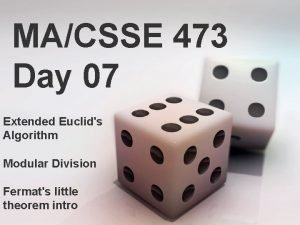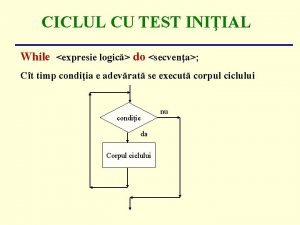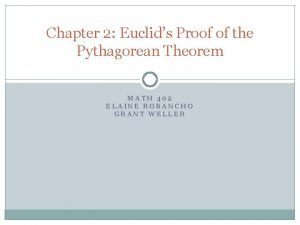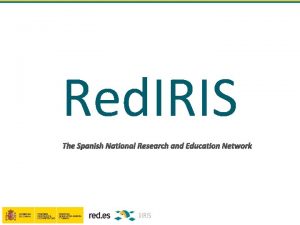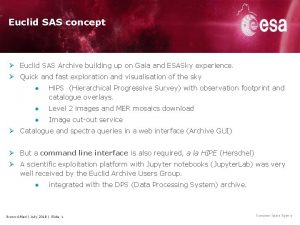EUCLID Consortium Euclid UK on IRIS Mark Holliman









- Slides: 9

EUCLID Consortium Euclid UK on IRIS Mark Holliman SDC-UK Deputy Lead Wide Field Astronomy Unit Institute for Astronomy University of Edinburgh 03/04/2019 IRIS F 2 F Meeting, Apr 2019

EUCLID Consortium Euclid Summary • ESA Medium-Class Mission – – – • • Largest astronomical consortium in history: 15 countries, ~2000 scientists, ~200 institutes. Mission data processing and hosting will be spread across 9 Science Data Centres in Europe and US (each with different levels of commitment). Scientific Objectives – – • In the Cosmic Visions Programme M 2 slot (M 1 Solar Orbiter, M 3 PLATO) Due for launch December 2021 To understand the origins of the Universe’s accelerated expansion Using at least 2 independent complementary probes (5 probes total) Geometry of the universe: • Weak Lensing (WL) Galaxy Clustering (GC) Cosmic history of structure formation: • WL, Redshift Space Distortion (RSD), Clusters of Galaxies (CL) Euclid on IRIS in 2018: – First use of Slurm as a service (Saas) deployment on IRIS resources at Cambridge on the not-quite-decommissioned Darwin cluster with support from Cambridge HPC and Stack HPC teams • Used for Weak Lensing pipeline sensitivity test simulations • ~15 k cores for 8 weeks from August-October • Generated ~200 TB of simulations data on the Lustre shared filesystem during that time (along with ~2 TB of data on a smaller Ceph • • 03/04/2019 system) User logins through SSH, jobs run through Slurm DRM head node, workload managed by the Euclid IAL software and pipeline executables distributed through CVMFS (as per mission requirements). Successful example of Saas, and now we’d like to see the Saas tested/operated on a federated basis IRIS F 2 F Meeting, Apr 2019

EUCLID Consortium Euclid UK on IRIS in 2019 • Three main areas of work: – Shear Lensing Simulations: Large scale galaxy image generation and analysis simulations (similar to the simulations run on IRIS at Cambridge in 2018, though larger in scope). – Mission Data Processing scale out: Proof of concept using IRIS Slurm as a Service (Saas) infrastructure to scale out workloads from the dedicated cluster in Edinburgh to resources at other IRIS providers. – Science Working Group Simulations (led by Tom Kitching): Science Performance Verification (SPV) simulations for setting the science requirements of the mission, and used to assess the impact of uncertainty in the system caused by any particular pipeline function or instrument calibration algorithm. • IRIS 2019 Allocations (all on Open. Stack, preferably using Saas) – SCD: 750 cores – Di. RAC: 1550 cores – Grid. PP: 800 cores 03/04/2019 IRIS F 2 F Meeting, Apr 2019

EUCLID Consortium Shear Lensing Simulations • • Description of work: The success of Euclid to measure Dark Energy to the required accuracy relies on the ability to extract a tiny Weak Gravitational Lensing signal (a 1% distortion of galaxy shapes) to high-precision (an error on the measured distortion of 0. 001%) and high accuracy (residual biases in the measured distortion below 0. 001%), per galaxy (on average), from a large data-set (1. 5 billion galaxy images). Both errors and biases are picked up at every step of the analysis. We are tasked with testing the galaxy model-fitting algorithm the UK has developed to extract this signal and to demonstrate it will work on the Euclid data, ahead of ESA Review and code-freezing for Launch. Working environment – – – • Nodes/containers running Cent. OS 7 CVMFS access to euclid. in 2 p 3. fr and euclid-dev. in 2 p 3. fr repositories 2 GB RAM per core, cores can be virtual Shared filesystem visible to the head node and workers. Preferably with high sequential IO rates (Ceph, Lustre, etc) Slurm DRM Preferably the Euclid job submission service (called the IAL) needs to be running on/near the head node for overall workflow management Use of IRIS Resources – Saas cluster running at Cambridge on Open. Stack (1550 cores) • – Saas cluster running at RAL on Open. Stack (750 cores) • 03/04/2019 Ceph Shared FS Shared filesystem TBD – options include using Ceph ansible to make a converged file system across the workers, or creating a single NFS host with a reasonable amount of block storage to mount on the workers. Tests are in progress. IRIS F 2 F Meeting, Apr 2019

EUCLID Consortium Mission Data Processing • Description of work: Euclid Mission Data Processing will be performed at 9 Science Data Centres (SDCs) across Europe and the US. Each SDC will process a subsection of the sky using the full Euclid pipeline, and resulting data will be hosted at archive nodes at each SDC throughout the mission. The expected processing workflow will follow these steps: 1. 2. 3. 4. 5. 6. 03/04/2019 Telescope data is transferred from satellite to ESAC. Level 1 processing occurs locally (removal of instrumentation effects, insertion of metadata). Level 1 data is copied to target SDCs (targets are determined by national Mission Level Agreements, and distribution is handled automatically by the archive). Associated external data (DES, LSST, etc) is distributed to the target SDCs (this could occur prior to arrival of Level 1 data). Level 2 data is generated at each SDC by running the full Euclid pipeline end-to-end on the local data (both mission and external). Results are stored in a local archive node, and registered with the central archive. Necessary data products are moved to Level 3 SDCs for processing of Level 3 data (LE 3 data is expected to require specialized infrastructure in many cases, such as GPUs or large shared memory machines). Data Release products are declared by the Science Ground Segment Operators and then copied back to the Science Operations Centre (SOC) at ESAC for official release to the community. Older release data, and or intermediate data products, are moved from disk to tape on a regular schedule. The data movement is handled by the archive nodes, using local storage services. IRIS F 2 F Meeting, Apr 2019

EUCLID Consortium SDC-UK Architecture 03/04/2019 IRIS F 2 F Meeting, Apr 2019

EUCLID Consortium Mission Data Processing con’t • Working Environment Nodes/containers running Cent. OS 7 CVMFS access to euclid. in 2 p 3. fr and euclid-dev. in 2 p 3. fr repositories 8 GB RAM per core, cores can be virtual Shared filesystem visible to the head node and workers. Preferably with high sequential IO rates (Ceph, Lustre, etc) – Torque/SGE/Slurm DRM – Euclid job submission service (called the IAL) needs to be running on/near the head node for overall workflow management – – • Use of IRIS Resources – The goal is to have a working Saas solution tied into our existing infrastructure by 2020 for the final phase of Euclid end-to-end pipeline tests. – Preliminary tests will occur in 2019, based around a Slurm head node running on the Edinburgh Open. Stack instance, with workers running on the Manchester Open. Stack instance (and likely others). This setup will require use of VPN type networking to connect the workers to the head node. These tests will include use of a multi-site converged Ceph. FS for shared storage. – Expected resource utilization is only 100 cores for 2019. 03/04/2019 IRIS F 2 F Meeting, Apr 2019

EUCLID Consortium Science Working Group • • Description of work: The Science Working Groups (SWG) are the name of the entities in Euclid that before launch set the science requirements for the algorithm developers and also the instrument teams, and assess the expected scientific performance of the mission. The UK leads the weak lensing SWG (WLSWG; Kitching), which in 2019 is tasked with Science Performance Verification (SPV) for testing the Euclid weak lensing pipeline. The current version of SPV simulations take a catalogue of galaxies from an n-body simulation and creates a transfer-function like chain of effects whereby the properties of each galaxy are modified by astrophysical, telescope, detector, and measurement process effects. These modified galaxy catalogues are then used to assess the performance of the mission as well as the impact of uncertainty in the system caused by pipeline algorithms or instrument calibration algorithms. Working Environment: – – • Nodes/containers running Cent. OS 7 Python 2 (with additional scientific libraries) 6 GB RAM per core, cores can be virtual Shared filesystem (for data workflow management) Use of IRIS Resources – – – 03/04/2019 700 Cores on Manchester Open. Stack Shared FS will need to be sorted, with the lead possibility being the use of a converged Ceph system (the same system tested for the Mission Data Processing work). A local NFS node with sufficient block storage could be used as a fallback. Saas head node will likely run on the Edinburgh Open. Stack, connected to workers through VPN IRIS F 2 F Meeting, Apr 2019

EUCLID Consortium Euclid UK on IRIS 2020… • Shear pipeline sensitivity testing – The UK developed pipeline algorithms need to be tested at scale pre-launch (Dec 2021) to ensure accuracy and performance, and then yearly simulations will need to be run post-launch for generating and refining calibration data. – – • Mission Data Processing – Euclid UK will have a dedicated cluster for day-to-day data processing over the course of the mission, but it is expected that this will be insufficient at peak periods (i. e. official data releases, data reprocessing). During these periods we need to scale out onto other resource providers, ideally through an Saas system (or something equivalent). It is also likely that we would want to use a shared tape storage system for archiving older Euclid data. – – • Pre-launch simulations are estimated to require ~3 k core years per year, and 200 TB of intermediate (shared) file storage. Post-launch simulation are estimated to require ~1. 5 k core years per year, and 100 TB of intermediate (shared) file storage. Estimates currently anticipate ~1. 5 k core years and 100 TB of intermediate (shared) file storage from 20222024. Data tape estimates are currently very fuzzy while we await the mission MLA’s to be finalized, but they should be on the order of growing 100 TB a year per year from 2020 onwards Science Working Group – The weak lensing SWG anticipates a similar need for simulations in 2020 as in 2019 (1. 5 k core years). But then the SWG expects to ramp up significantly on launch year and beyond, running a suite of simulations for verifying mission science requirements and data analysis – – – 03/04/2019 2021 - 4 k core years, 100 TB of intermediate (shared) file storage 2022 – 5 k core years 200 TB of intermediate (shared) file storage 2023 – 5 k core years 200 TB of intermediate (shared) file storage IRIS F 2 F Meeting, Apr 2019
